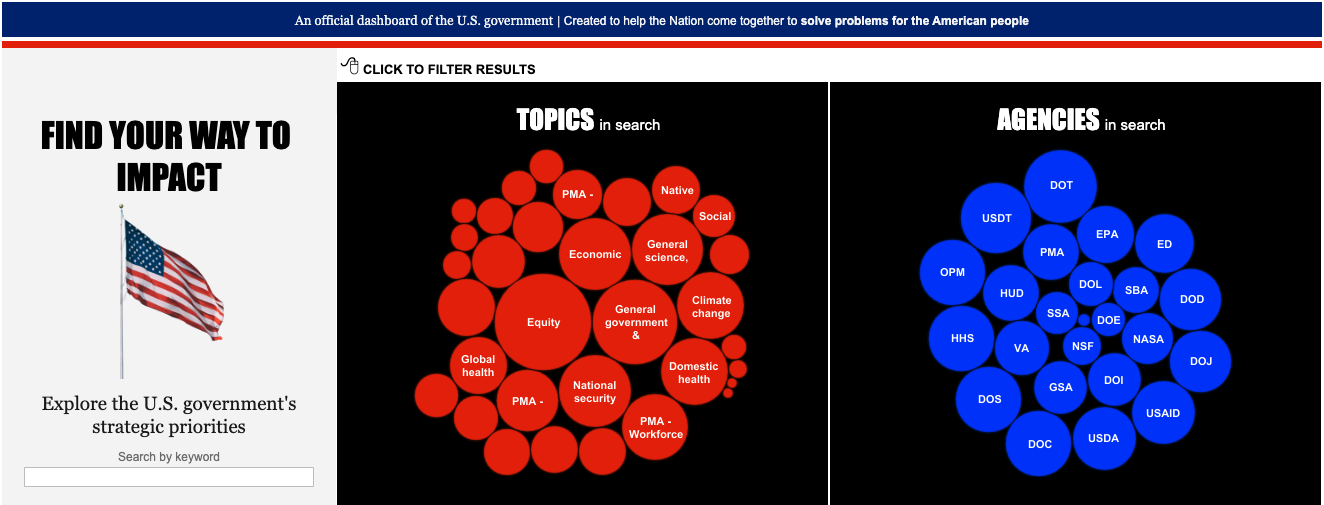Reporting on our achievements, as well as the barriers we face, is a significant aspect of our personal and professional lives. Whether it’s quarterly reviews at work or sharing milestones on social media, we want to highlight our progress and demonstrate how we address challenges, making improvements along the way.
Progress reporting isn’t limited to individuals or private organizations. Federal law requires government agencies to provide regular updates on their journey towards achieving their goals. What barriers, if any, are preventing an agency from reaching their goals? What corrective actions will be taken to get back on track? The GPRA Modernization Act of 2010 requires government agencies to provide quarterly updates on their progress in achieving Agency Priority Goals (APGs) to Performance.gov, setting the stage for a new era of transparency and results-driven governance.
What are APGs?
APGs are near-term achievements in an agency’s strategic plan that improve outcomes, customer experience, or efficiency. These goals serve as stepping stones towards long-term objectives outlined in the agency’s strategic plan. APGs rely on agency execution rather than new legislation or funding. While APGs reflect the top priorities of agency leadership and the Administration, they may not cover the entirety of the agency’s mission.
What’s the importance of an APG?
Regular progress reviews of these goals ensure focus and allocation of resources. Other goals and priorities exist, and agencies should manage them according to priority levels.
What should an agency consider when setting these goals?
Successful APGs address a problem and have a set completion date, target, and indicator for success. These goals:
-
Advance priorities for agency leadership and the Administration
-
Rely predominantly on strong agency execution to be accomplished, not new legislation or additional funding
-
Support improvements in near-term outcomes, customer service, or efficiencies, and advance progress toward longer-term outcome-focused goals in the agency’s strategic plan
-
Are ambitious yet achievable within the end of a 24-month period
-
Organize efforts in areas where cross component/bureau or joint-agency coordination is needed to advance common outcomes
What is an example of an APG?
Let’s look at the Department of Commerce. One of Commerce’s FY 2022-2023 APGs is to strengthen the global competitiveness of American businesses. In order to achieve this high level goal, Commerce outlines a tangible target: the International Trade Association (ITA) will double the annual number of clients assisted from 38,000 in FY 2020 to 76,000 in FY 2023, with a particular focus on small and medium-sized enterprises (SMEs) and underserved communities.
By establishing a measurable goal target, the agency can effectively communicate quantitative updates on a quarterly basis, including any barriers along with supporting data. In April 2023, ITA reported that although it did not achieve 100% of its quarterly target for total number of clients assisted, they are still projected to fully meet all of its performance targets within the two-year timeframe of this APG. The quarterly update highlights key initiatives that are helping achieve this, such as the co-hosted virtual Women’s Funding Summit, an event connecting women-owned businesses to resources to help their businesses grow.
What time period do APGs span?
An APG is a two-year goal, although it can contribute to longer-term goals. Indicators used to track progress against the goals should cover the full fiscal year to the extent possible, and quarterly indicators and/or milestones will follow the fiscal year quarters. Agencies may choose monthly indicators and milestones, if preferred.
APGs are updated every two years…what happens to the previous APGs once a new set is established?
The APGs of previous cycles (for example, FYs 2016–2017, FYs 2018–2019) are archived and remain publicly available on Performance.gov.
How can I search for updates and/or goals?
Are you wondering what the Federal Government is working on to improve agriculture, education, or national security? Do you want to easily find out what the Department of Justice or the Department of Labor has set for their two year goals? The Strategic Goal Dashboard on Performance.gov makes it easy to filter by agency and topic to explore overviews and updates on what the Federal Government achieves for the American people.

The end of the goal period approaches…and a new one begins!
As we approach the end of the goal period on Sept. 30, 2023, we look forward to a new set of APGs from major federal agencies. Reporting of APGs plays a vital role in fostering transparency and accountability within government agencies. By embracing progress reporting, agencies can enhance their impact, deliver on strategic objectives, and ultimately serve the needs and livelihoods of the public they represent.
For more information on APGs, check out Section 250—Agency Priority Goals from OMB Circular No. A-11: Preparation, Submission, and Execution of the Budget.
Stay Informed
Follow along with Performance.gov on LinkedIn and Twitter as we highlight different agencies and their goals. We will continue to update Performance.gov quarterly with progress on agency and PMA priorities and strategies.
Subscribe to our newsletter to receive updates in your inbox.




